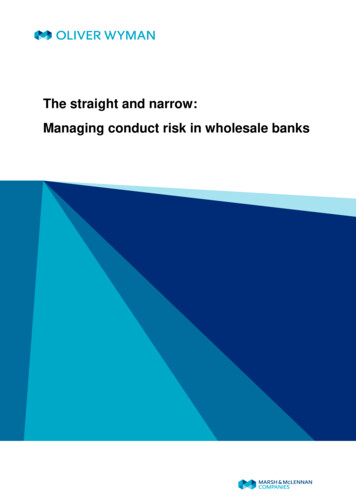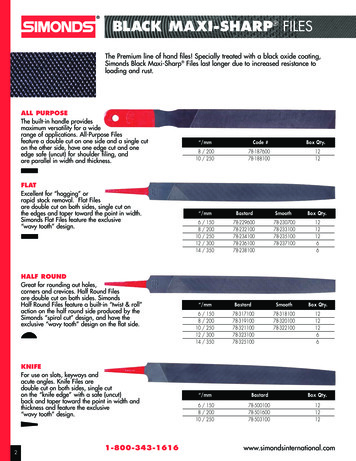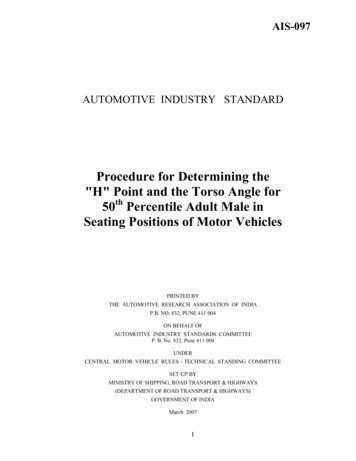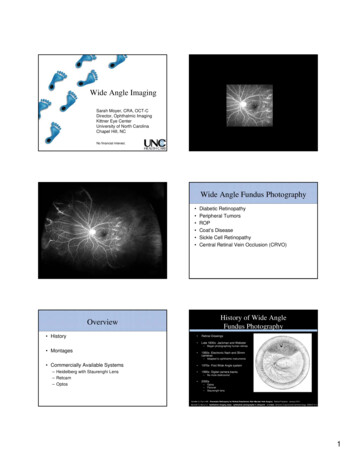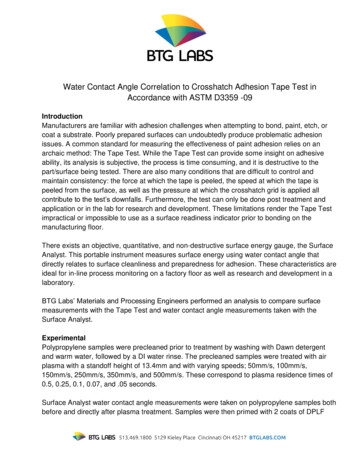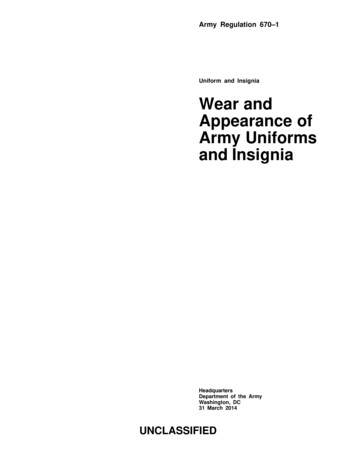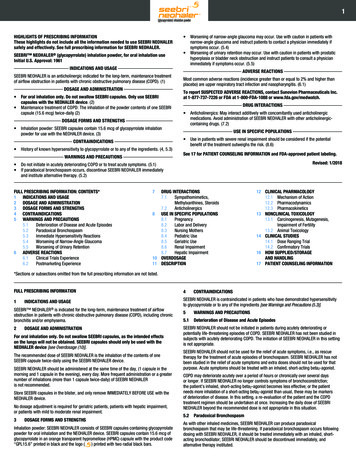
Transcription
1HIGHLIGHTS OF PRESCRIBING INFORMATIONThese highlights do not include all the information needed to use SEEBRI NEOHALERsafely and effectively. See full prescribing information for SEEBRI NEOHALER.SEEBRI NEOHALER (glycopyrrolate) inhalation powder, for oral inhalation useInitial U.S. Approval: 1961INDICATIONS AND USAGESEEBRI NEOHALER is an anticholinergic indicated for the long-term, maintenance treatmentof airflow obstruction in patients with chronic obstructive pulmonary disease (COPD). (1)DOSAGE AND ADMINISTRATION For oral inhalation only. Do not swallow SEEBRI capsules. Only use SEEBRIcapsules with the NEOHALER device. (2) Maintenance treatment of COPD: The inhalation of the powder contents of one SEEBRIcapsule (15.6 mcg) twice-daily (2)DOSAGE FORMS AND STRENGTHS Inhalation powder: SEEBRI capsules contain 15.6 mcg of glycopyrrolate inhalationpowder for use with the NEOHALER device. (3)CONTRAINDICATIONS History of known hypersensitivity to glycopyrrolate or to any of the ingredients. (4, 5.3)WARNINGS AND PRECAUTIONS Worsening of narrow-angle glaucoma may occur. Use with caution in patients withnarrow-angle glaucoma and instruct patients to contact a physician immediately ifsymptoms occur. (5.4) Worsening of urinary retention may occur. Use with caution in patients with prostatichyperplasia or bladder neck obstruction and instruct patients to consult a physicianimmediately if symptoms occur. (5.5)ADVERSE REACTIONSMost common adverse reactions (incidence greater than or equal to 2% and higher thanplacebo) are upper respiratory tract infection and nasopharyngitis. (6.1)To report SUSPECTED ADVERSE REACTIONS, contact Sunovion Pharmaceuticals Inc.at 1-877-737-7226 or FDA at 1-800-FDA-1088 or www.fda.gov/medwatch.DRUG INTERACTIONS Anticholinergics: May interact additively with concomitantly used anticholinergicmedications. Avoid administration of SEEBRI NEOHALER with other anticholinergiccontaining drugs. (7.2)USE IN SPECIFIC POPULATIONS Use in patients with severe renal impairment should be considered if the potentialbenefit of the treatment outweighs the risk. (8.6)See 17 for PATIENT COUNSELING INFORMATION and FDA-approved patient labeling.Revised: 1/2018 Do not initiate in acutely deteriorating COPD or to treat acute symptoms. (5.1) If paradoxical bronchospasm occurs, discontinue SEEBRI NEOHALER immediatelyand institute alternative therapy. (5.2)FULL PRESCRIBING INFORMATION: CONTENTS*1 INDICATIONS AND USAGE2 DOSAGE AND ADMINISTRATION3 DOSAGE FORMS AND STRENGTHS4 CONTRAINDICATIONS5 WARNINGS AND PRECAUTIONS5.1 Deterioration of Disease and Acute Episodes5.2 Paradoxical Bronchospasm5.3 Immediate Hypersensitivity Reactions5.4Worsening of Narrow-Angle Glaucoma5.5Worsening of Urinary Retention6 ADVERSE REACTIONS6.1Clinical Trials Experience6.2Postmarketing Experience7DRUG INTERACTIONS7.1 Sympathomimetics,Methylxanthines, Steroids7.2 Anticholinergics8 USE IN SPECIFIC POPULATIONS8.1Pregnancy8.2Labor and Delivery8.3Nursing Mothers8.4Pediatric Use8.5Geriatric Use8.6Renal Impairment8.7Hepatic Impairment10 OVERDOSAGE11 DESCRIPTION12 CLINICAL PHARMACOLOGY12.1 Mechanism of Action12.2 Pharmacodynamics12.3 Pharmacokinetics13 NONCLINICAL TOXICOLOGY13.1 C arcinogenesis, Mutagenesis,Impairment of Fertility13.2 Animal Toxicology14 CLINICAL STUDIES14.1 Dose Ranging Trial14.2 Confirmatory Trials16 HOW SUPPLIED/STORAGEAND HANDLING17 PATIENT COUNSELING INFORMATION*Sections or subsections omitted from the full prescribing information are not listed.FULL PRESCRIBING INFORMATION41SEEBRI NEOHALER is contraindicated in patients who have demonstrated hypersensitivityto glycopyrrolate or to any of the ingredients [see Warnings and Precautions (5.3)].INDICATIONS AND USAGESEEBRI NEOHALER is indicated for the long-term, maintenance treatment of airflowobstruction in patients with chronic obstructive pulmonary disease (COPD), including chronicbronchitis and/or emphysema.2DOSAGE AND ADMINISTRATIONFor oral inhalation only. Do not swallow SEEBRI capsules, as the intended effectson the lungs will not be obtained. SEEBRI capsules should only be used with theNEOHALER device [see Overdosage (10)].The recommended dose of SEEBRI NEOHALER is the inhalation of the contents of oneSEEBRI capsule twice-daily using the SEEBRI NEOHALER device.SEEBRI NEOHALER should be administered at the same time of the day, (1 capsule in themorning and 1 capsule in the evening), every day. More frequent administration or a greaternumber of inhalations (more than 1 capsule twice-daily) of SEEBRI NEOHALERis not recommended.Store SEEBRI capsules in the blister, and only remove IMMEDIATELY BEFORE USE with theNEOHALER device.No dosage adjustment is required for geriatric patients, patients with hepatic impairment,or patients with mild to moderate renal impairment.3DOSAGE FORMS AND STRENGTHSInhalation powder: SEEBRI NEOHALER consists of SEEBRI capsules containing glycopyrrolatepowder for oral inhalation and the NEOHALER device. SEEBRI capsules contain 15.6 mcg ofglycopyrrolate in an orange transparent hypromellose (HPMC) capsule with the product code“GPL15.6” printed in black and the logo ( ) printed with two radial black bars.CONTRAINDICATIONS5WARNINGS AND PRECAUTIONS5.1Deterioration of Disease and Acute EpisodesSEEBRI NEOHALER should not be initiated in patients during acutely deteriorating orpotentially life-threatening episodes of COPD. SEEBRI NEOHALER has not been studied insubjects with acutely deteriorating COPD. The initiation of SEEBRI NEOHALER in this settingis not appropriate.SEEBRI NEOHALER should not be used for the relief of acute symptoms, i.e., as rescuetherapy for the treatment of acute episodes of bronchospasm. SEEBRI NEOHALER has notbeen studied in the relief of acute symptoms and extra doses should not be used for thatpurpose. Acute symptoms should be treated with an inhaled, short-acting beta2-agonist.COPD may deteriorate acutely over a period of hours or chronically over several daysor longer. If SEEBRI NEOHALER no longer controls symptoms of bronchoconstriction;the patient’s inhaled, short-acting beta2-agonist becomes less effective; or the patientneeds more inhalation of a short-acting beta2-agonist than usual, these may be markersof deterioration of disease. In this setting, a re-evaluation of the patient and the COPDtreatment regimen should be undertaken at once. Increasing the daily dose of SEEBRINEOHALER beyond the recommended dose is not appropriate in this situation.5.2Paradoxical BronchospasmAs with other inhaled medicines, SEEBRI NEOHALER can produce paradoxicalbronchospasm that may be life-threatening. If paradoxical bronchospasm occurs followingdosing with SEEBRI NEOHALER, it should be treated immediately with an inhaled, shortacting bronchodilator; SEEBRI NEOHALER should be discontinued immediately, andalternative therapy instituted.
25.3 Immediate Hypersensitivity Reactions52-Week TrialImmediate hypersensitivity reactions have been reported after administration of SEEBRINEOHALER. If signs suggesting allergic reactions occur, in particular, angioedema (includingdifficulties in breathing or swallowing, swelling of the tongue, lips, and face), urticaria, or skinrash, SEEBRI NEOHALER should be discontinued immediately and alternative therapy instituted.SEEBRI NEOHALER should be used with caution in patients with severe hypersensitivity tomilk proteins.In a long-term safety trial, 507 subjects were treated for up to 52 weeks with glycopyrrolate15.6 mcg twice-daily or indacaterol 75 mcg once-daily. The demographic and baselinecharacteristics of the long-term safety trial were similar to those of the placebo-controlledefficacy trials described above. The adverse reactions reported in the long-term safety trialwere consistent with those observed in the placebo-controlled trials of 12 weeks. Additionaladverse reactions that occurred with a frequency greater than or equal to 2% in the groupreceiving glycopyrrolate 15.6 mcg twice-daily that exceeded the frequency of indacaterol75 mcg once-daily in this trial were: diarrhea, nausea, upper abdominal pain, fatigue,bronchitis, pneumonia, rhinitis, back pain, arthralgia, dyspnea, and wheezing.5.4Worsening of Narrow-Angle GlaucomaSEEBRI NEOHALER should be used with caution in patients with narrow-angle glaucoma.Prescribers and patients should be alert for signs and symptoms of acute narrowangle glaucoma (e.g., eye pain or discomfort, blurred vision, visual halos or coloredimages in association with red eyes from conjunctival congestion and corneal edema).Instruct patients to consult a physician immediately should any of these signs orsymptoms develop.5.5Worsening of Urinary RetentionSEEBRI NEOHALER should be used with caution in patients with urinary retention.Prescribers and patients should be alert for signs and symptoms of urinary retention(e.g., difficulty passing urine, painful urination), especially in patients with prostatichyperplasia or bladder-neck obstruction. Instruct patients to consult a physicianimmediately should any of these signs or symptoms develop.6ADVERSE REACTIONSThe following adverse reactions are described in greater detail, in other sections Paradoxical bronchospasm [see Warnings and Precautions (5.2)]. Immediate hypersensitivity reactions [see Warnings and Precautions (5.3)]. Worsening of narrow-angle glaucoma [see Warnings and Precautions (5.4)]. Worsening of urinary retention [see Warnings and Precautions (5.5)].6.1Clinical Trials ExperienceBecause clinical trials are conducted under widely varying conditions, the adverse reactionrates observed in the clinical trials of a drug cannot be directly compared to rates in clinicaltrials of another drug and may not reflect the rates observed in clinical practice.6.2Postmarketing ExperienceThe following additional adverse reactions have been identified during worldwide postapproval use of glycopyrrolate, the active ingredient in SEEBRI NEOHALER, at higher thanthe recommended dose. Because these reactions are reported voluntarily from a populationof uncertain size, it is not always possible to reliably estimate their frequency or establisha causal relationship to drug exposure. These adverse reactions are: angioedema,paradoxical bronchospasm and dysphonia.7DRUG INTERACTIONS7.1Sympathomimetics, Methylxanthines, SteroidsIn clinical studies, concurrent administration of short-acting and long-actingsympathomimetic (beta-agonists) bronchodilators (including indacaterol), methylxanthines,oral and inhaled steroids with SEEBRI NEOHALER showed no increases in adversedrug reactions.7.2AnticholinergicsThere is a potential for an additive interaction with concomitantly used anticholinergicmedications. Therefore, avoid coadministration of SEEBRI NEOHALER with otheranticholinergic-containing drugs as this may lead to an increase in anticholinergiceffects [see Warnings and Precautions (5.4, 5.5) and Adverse Reactions (6)].8USE IN SPECIFIC POPULATIONS8.1PregnancyTeratogenic Effects: Pregnancy Category CThe SEEBRI NEOHALER safety database included 3415 subjects with COPD in four12-week lung function trials and one 52-week long-term safety study. A total of1202 subjects received treatment with SEEBRI NEOHALER 15.6 mcg twice-daily (BID).The safety data described below are based on the four 12-week trials and the one52-week trial.There are no adequate and well-controlled studies with SEEBRI NEOHALER in pregnantwomen. Because animal reproduction studies are not always predictive of human response,SEEBRI NEOHALER should only be used during pregnancy if the potential benefit to thepatient justifies the potential risk to the fetus. Women should be advised to contact theirphysician if they become pregnant while taking SEEBRI NEOHALER.12-Week TrialsGlycopyrrolate was not teratogenic in Wistar rats and New Zealand White rabbits atapproximately 1400 and 530 times, respectively, the MRHD in adults (on an AUC basis atmaternal inhaled doses up to 3.83 mg/kg/day in rats and up to 4.4 mg/kg/day in rabbits).The incidence of adverse reactions associated with SEEBRI NEOHALER in Table 1 is based onfour 12-week, placebo-controlled trials in 2908 subjects with COPD. In the total population,61.2% of patients had moderate COPD and 37.8% had severe COPD. In these trials,951 subjects received SEEBRI NEOHALER 15.6 mcg BID, 511 subjects received indacaterol27.5 mcg BID, 508 subjects received a fixed-dose combination of indacaterol/glycopyrrolate27.5 mcg/15.6 mcg BID, and 938 subjects received placebo. Overall, 62% were males,90% were Caucasian, and the mean age was 63 years (ranging from 41 to 89 years). In thispopulation, 53% were identified as current smokers with an average smoking history of48 pack-years.The most common adverse reactions (incidence greater than or equal to 2% and higherthan placebo) were upper respiratory tract infection and nasopharyngitis.The proportion of subjects who discontinued treatment due to adverse reactions was 2.4%for the SEEBRI NEOHALER-treated patients and 3.8% for placebo-treated patients.Table 1. Adverse reactions with SEEBRI NEOHALER (greater than orequal to 1% incidence and higher than placebo) in COPD patientsGlycopyrrolate had no effects on peri-natal and post-natal developments in rats atapproximately 1100 times the MRHD in adults (on an AUC basis at maternal subcutaneousdoses up to 1.88 mg/kg/day).8.2Labor and DeliveryThere are no adequate and well-controlled human trials that have investigated the effects ofSEEBRI NEOHALER during labor and delivery. In human parturients undergoing Caesareansection, 86 minutes after a single intramuscular injection of 0.006 mg/kg glycopyrrolate,umbilical plasma concentrations were low.8.3Nursing MothersIt is not known whether SEEBRI NEOHALER is excreted in human breast milk. Because manydrugs are excreted in human milk, caution should be exercised when SEEBRI NEOHALERis administered to a nursing woman. Since there are no data from well-controlled humanstudies on the use of SEEBRI NEOHALER by nursing mothers, a decision should be madewhether to discontinue nursing or to discontinue SEEBRI NEOHALER, taking into account theimportance of SEEBRI NEOHALER to the mother.SEEBRI NEOHALER15.6 mcg BID(N 951)n (%)(N 938)n (%)Upper respiratory tract infection32 (3.4)22 (2.3)Nasopharyngitis20 (2.1)18 (1.9)Urinary tract infection13 (1.4)12 (1.3)SEEBRI NEOHALER is not indicated for use in children. The safety and efficacy of SEEBRINEOHALER in pediatric patients have not been established.Sinusitis13 (1.4)7 (0.7)8.5Adverse ReactionOropharyngeal pain17 (1.8)PlaceboNon-teratogenic Effects:11 (1.2)Other adverse reactions occurring more frequently with SEEBRI NEOHALER than withplacebo, but with an incidence of less than 1% include rash, pruritus, gastroenteritis,hypersensitivity, atrial fibrillation, insomnia, pain in extremity, dysuria, vomiting, productivecough, and diabetes mellitus/hyperglycemia.It is not known whether glycopyrrolate is excreted in human breast milk. Glycopyrrolate(including its metabolites) have been detected in the milk of lactating rats and reached up to10-fold higher concentrations in the milk than in the blood of the dam.8.4Pediatric UseGeriatric UseBased on available data, no adjustment of the dosage of SEEBRI NEOHALER in geriatricpatients is warranted. SEEBRI NEOHALER can be used at the recommended dose in elderlypatients 75 years of age and older.Of the total number of subjects in clinical studies of SEEBRI NEOHALER, 45% were aged65 and older, while 10% were aged 75 and older. No overall differences in safety oreffectiveness were observed between these subjects and younger subjects, and other
3reported clinical experience has not identified differences in responses between the elderlyand younger patients, but greater sensitivity of some older individuals cannot be ruled out.8.6Renal ImpairmentNo dose adjustment is required for patients with mild and moderate renal impairment.SEEBRI NEOHALER should be used in patients with severe renal impairment (estimatedGFR less than 30 mL/min/1.73m2), including those with end-stage renal disease requiringdialysis, if the expected benefit outweighs the potential risk since the systemic exposure toglycopyrrolate may be increased in this population [see Clinical Pharmacology (12.3)].8.7Hepatic ImpairmentNo dose adjustment is required for patients with hepatic impairment. The effects of hepaticimpairment on the pharmacokinetics of glycopyrrolate have not been studied [see ClinicalPharmacology (12.3)].10OVERDOSAGEAn overdose of glycopyrrolate may lead to anticholinergic signs and symptoms such asnausea, vomiting, dizziness, lightheadedness, blurred vision, increased intraocularpressure (causing pain, vision disturbances, or reddening of the eye), obstipation ordifficulties in voiding.In COPD patients, repeated orally inhaled administration of SEEBRI NEOHALER at totaldoses of 124.8 and 249.6 mcg once-daily for 28 days were well tolerated.Accidental ingestion: Acute intoxication by inadvertent oral ingestion of SEEBRINEOHALER capsules is unlikely due to the low oral bioavailability (about 5%)[see Clinical Pharmacology (12.3)].Peak plasma levels and total systemic exposure following intravenous administration of150 mcg glycopyrrolate (equivalent to 120 mcg active moiety) in healthy volunteers wererespectively about 270-fold and 13-fold higher than the peak and total systemic exposureat steady-state achieved with the recommended daily dose of 31.2 mcg of glycopyrrolate(i.e., 15.6 mcg glycopyrrolate twice-daily) and were well-tolerated.11DESCRIPTIONSEEBRI NEOHALER consists of SEEBRI capsules and a NEOHALER device. Each SEEBRIcapsule contains a dry powder formulation of glycopyrrolate packaged in orange transparenthypromellose (HPMC) capsules for oral inhalation with the NEOHALER device only.Each orange transparent HPMC capsule contains 15.6 mcg of glycopyrrolate blended withapproximately 25 mg of lactose monohydrate (which contains trace levels of milk protein)and 0.04 mg of magnesium stearate.Glycopyrrolate, the active component of SEEBRI NEOHALER, is chemically described acetyl) oxy]-1,1-dimethylpyrrolidiniumbromide. This synthetic quaternary ammonium compound acts as a competitive antagonistat muscarinic acetylcholine receptors, also referred to as anticholinergic. Glycopyrrolate,C19H28BrNO3, is a white powder that is freely soluble in water and sparingly soluble inabsolute ethanol. It has a molecular mass of 398.33. The structural formula is:12.2 PharmacodynamicsCardiac ElectrophysiologyThe effect of SEEBRI NEOHALER on the QTc interval was evaluated in a Phase 1 randomizedplacebo and positive controlled double-blind, single-dose, crossover thorough QTc study in73 healthy subjects. At the dose 16-fold the therapeutic daily dose, SEEBRI NEOHALER didnot prolong QTc to any clinically relevant extent.12.3 PharmacokineticsLinear pharmacokinetics of glycopyrrolate was observed following inhalation of daily dosesof 31.2 mcg to 249.6 mcg.AbsorptionFollowing oral inhalation using the NEOHALER inhaler, glycopyrrolate was rapidly absorbedand reached peak plasma levels at 5 minutes post dose.The absolute bioavailability of glycopyrrolate inhaled via SEEBRI NEOHALER was estimatedto be about 40%. About 90% of systemic exposure following inhalation is due to lungabsorption and 10% is due to gastrointestinal absorption.Following repeated once-daily inhalation in patients with COPD, PK steady-state ofglycopyrrolate was reached within 1 week of treatment. There was no indication that theglycopyrrolate pharmacokinetics changes over time.DistributionAfter intravenous administration, the steady-state volume of distribution of glycopyrrolatewas 83 L and the volume of distribution in the terminal phase was 376 L. The in vitrohuman plasma protein binding of glycopyrrolate was 38% to 41% at concentrations of1 to 10 ng/mL.MetabolismIn vitro metabolism studies show glycopyrrolate hydroxylation resulting in a varie
dosing with SEEBRI NEOHALER, it should be treated immediately with an inhaled, short-acting bronchodilator; SEEBRI NEOHALER should be discontinued immediately, and alternative therap
